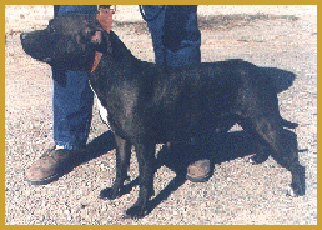Breed Specific Legislation
A letter regarding Breed Specific Legislation
by Robert Simon
Robert Simon, an American living in Holland and a Stafford owner, wrote the following letter to the Editor of the Calgary Herald (Canada) after the publication of a singularly biased article written by Naomi Lakritz:
Dear Mr. Cotton,
I recently read--and was much dismayed--by an article on the subject of "pitbulls" by Naomi Lakritz in the Calgary Herald . As a dog owner (originally from the US and living for some years in the Netherlands), I find very worrisome any call anywhere for Breed Specific Legislation, and as the owner of a Staffordshire Bull Terrier, which is often placed under the "pitbull" rubric, these worries become quite personal.
I am as well a writer and a historian, and I find it disturbing that Ms. Lakritz apparently did little research in producing what must be characterized as an inflammatory and demagogic piece. I have no problem with journalism based upon personal opinion; in fact having been publishing art and culture criticism for nearly 15 years a good part of my own writing is necessarily the expression of a very personal point-of-view.
But I firmly believe that when someone writes something that can have real effects in the world, rouse strong sentiments, and--in this case--aims to bring about legislation directed at much-loved family companions, they should act with a high level of responsibility, and do their homework.
A few hours at the library or on the web would have provided Ms. Lakritz with the material to write a far more cogent and serious piece, even if after doing so she remained committed to some form of Breed Specific Legislation. But if indeed Ms. Lakritz--after a bit of research--would maintain such a view, it would have to somehow contend with the great preponderance of evidence and expert opinion stating that BSL is ineffective, impractical, and counter-productive.
Moreover, it has become clear that the statistical evidence often marshaled to support BSL is essentially without value, a determination based upon the debilitating limitations of current methodologies of data collection and interpretation. I realize of course that Ms. Lakritz' piece is essentially anecdotal, and there is nothing wrong with anecdotes, but as I said earlier, I do believe that demands for political and legislative action ought to be founded on a higher standard of argument and information gathering.
I offer some material from two sources available on the web. First, from the Humane Society of the United States, and second, and most significantly, from the recently convened American Veterinary Medical Association Task Force on Canine Aggression and Human-Canine Interaction.
The following appeared as a sidebar to an article by Leslie Sinclair, D.V.M., "Would I bite?", which can be accessed on the website of the Humane Society of the United States HSUS) at this address:
(This link no longer works as of 2007)
http://www.hsus.org/programs/companion/dogs/wouldibite.html
I quote:
When Breed Should be Ignored
Can a law that bans or restricts ownership of specific breeds of dogs--called a "breed-specific law"--protect the members of your community from dog attacks?
According to experts, the answer is no.
Why? Popular breeds come and go. When ownership of one breed of dog is outlawed, those who want a dangerous dog simply turn to another breed. The Doberman pinscher--known as the dangerous dog breed of the 1970s-was replaced in popularity by the pit bull in the '80s and the Rottweiler in the '90s.
Breed-specific laws require that someone be able to prove that a specific dog is a member, or a mix, of that breed--not always an easy task. Boxers and bulldogs, for instance, may be mistaken for pit bulls. Any medium-large sized black and tan dog with a long tail may be mistakenly labeled as a German shepherd.
Breed-specific legislation doesn't acknowledge the fact that a dog of any breed can become dangerous. The law should protect your community from any such dog.
Breed-specific laws are difficult, costly, and sometimes impossible to enforce. It's one thing to require that every Rottweiler in your community be muzzled whenever outside of the home; it's another to fund and support adequate animal-control staff to ensure that this happens.
In 1987 the Cincinnati City Council banned all pit bulls within the city after a series of severe maulings and one human fatality involving the dogs. The ban was passed even though the state of Ohio and the city of Cincinnati already had statutes that allowed authorities to seize any dog known to have injured or killed a person or another dog. Nearly ten years later, the council's law committee recommended that the ban be repealed, saying that it was unnecessary. The council recommended that pit bulls be handled like any other dogs and that owners be prosecuted only when the dogs were unrestrained or exhibited dangerous behavior. It made this recommendation in part due to the cost of enforcement. Confiscated dogs spent up to five months at the city's contracted shelter while the cases against the dogs' owners were being litigated. Many of the confiscated dogs were family companions with no history of aggression.
Legislation that restricts breeds may actually create a population of dangerous dogs within your community. When a community imposes strict regulations on a specific breed of dog, owners of those dogs may end up chaining or caging the dogs for long periods of time. Dogs so chained or caged can be so desperate for activity that they become uncontrollable should they escape. Restricted dogs often receive little veterinary care because it is difficult for their owners to transport them to a veterinary facility without violating restrictions. Most importantly, restricted dogs who don't get to experience normal opportunities for socialization and training will undoubtedly act in an unpredictable fashion when exposed to the real world.
The HSUS advocates laws that penalize the owners of dogs, not the dogs themselves, for dangerous behavior. Breed-specific legislation doesn't acknowledge the fact that a dog of any breed--or mix--can become dangerous.
[end of quote]
Now some material from a second source.
To my knowledge, the work of the American Veterinary Medical Association (AVMA) Task Force--with an anticipated completion date of mid-1999--represents the most ambitious, comprehensive and authoritative effort ever undertaken, nationally in the US, or internationally, to examine the question of canine aggression in all of its complexities, and to propose concrete responses.
The passages I cite were published in the Journal of the American Veterinary Medical Association on October 15, 1998, and are available on the Journal's website at
(This link no longer works as of 2007)
http://www.avma.org/onlnews/javma/oct98/s101598a.htm
These are the aims and makeup of the Task Force. I quote:
New task force addresses canine aggression
During its inaugural meeting, Aug 15-17 [1998], the AVMA Task Force on Canine Aggression and Human-Canine Interactions began developing a multifaceted, community-oriented model program to address canine aggression and injury caused by dog bites. The 15-member task force includes representatives from the AVMA, the American College of Veterinary Behaviorists, the American Academy of Pediatrics, the American College of Emergency Physicians, the PLIT [Professional Liability Insurance Trust], the insurance industry, the American Medical Association, national humane organizations, the National Animal Control Association, the Centers for Disease Control and Prevention, and the legal profession.
Working from issues raised during breakout sessions of the 1996 AVMA Animal Welfare Forum on human-canine interactions, the task force identified needed components of a program to prevent dog bites. These included methods for reliable reporting, multidisciplinary/multiprofessional involvement, well-enforced ordinances to control dangerous dogs, education of health care professionals, public education, a media focus, and sufficient infrastructure to coordinate the program.
[end of quote]
And this is the view of the Task Force on the subject of Breed Specific Legislation. I quote:
Regulatory issues and legislation
Concerns about "dangerous" dogs have caused many local governments to consider supplementing or replacing existing animal control laws with breed-specific ordinances. Members of the task force agreed that current statistics on fatalities and injuries caused by dogs cannot be used to responsibly document the dangerousness of particular breeds.
Task force members believe that legislators can respond effectively to citizen pressure for action regarding "dangerous" dogs without introducing breed-specific ordinances. Dangerous dog laws can be enacted that appropriately place responsibility for dog behavior on owners and current laws, if appropriately enforced, are often sufficient.
During the next several months, members of the subcommittee on regulatory and professional issues will generate a document specifying what they believe should be included in effective legislation for the control of dangerous dogs, as well as the potential impact of civil remedies.
[end of quote]
I know that you have received other emailings from a number of participants in some international Staffordshire Bull Terrier internet lists, to which I happily belong. (Perhaps from other sources as well). It was through these lists that I first became aware of Ms. Lakritz' article. But it is worth saying that though the listmembers share many common concerns, we are in no way a formal, structured advocacy group, and have differing views on any number of particular dog-related matters, and different ways of conveying these concerns and views.
Speaking for myself, I do not write to you with the aim of impugning Ms. Lakritz' integrity or journalistic methods, though I stand by the critical remarks I made at the outset. Rather, it is my hope that you might see fit to publish some of these emailed responses--in whole or in part--in your newspaper, so another part of the "pitbull" story can be told and heard. The internet has created an unprecedented forum for the dissemination of information and opinion, and the events in Calgary as reported in the Calgary Herald have become part of an international discussion. Once again, it is my sincere hope that your newspaper will actively engage with this discussion.
Yours truly,
Robert Simon
Amsterdam
The Netherlands










